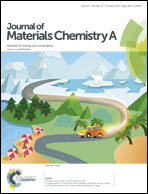Hydrothermal preparation of nanoporous TiO2 films with exposed {001} facets and superior photocatalytic activity
Abstract
TiO2 films with exposed {001} facets and uniform nanopores in the crystal facets were fabricated on a Ti substrate using the hydrothermal process followed by calcination at 600 °C. The effects of pretreatment of the Ti substrate and the hydrothermal conditions (volume ratio of water/isopropanol, hydrothermal time, temperature and HF concentration) on the formation of nanopores in the facets of the TiO2 crystals were investigated. The sizes of the nanopores can be controlled by adjusting the hydrothermal temperature. TG/DTA-MS analysis indicates that HF and isopropanol adsorbed on the Ti substrate are combusted into gas and released during calcination. The effects of cleaning and heat treatment of the hydrothermally treated Ti substrate indicate that the presence of residual organic matter and HF in the TiO2 facets and their transformation and reaction during calcination are essential for nanopore formation on the various facets of the TiO2 crystals. The as-prepared nanoporous TiO2 films with exposed {001} facets exhibit considerably higher UV photocatalytic activity for the degradation of pharmaceuticals and personal care products than non-porous TiO2 films with exposed {001} facets and P25 coated on the titanium sheet, revealing that the rational design and fabrication of the nanoporous TiO2 films is an effective method to improve the photocatalytic activity.


 Please wait while we load your content...
Please wait while we load your content...